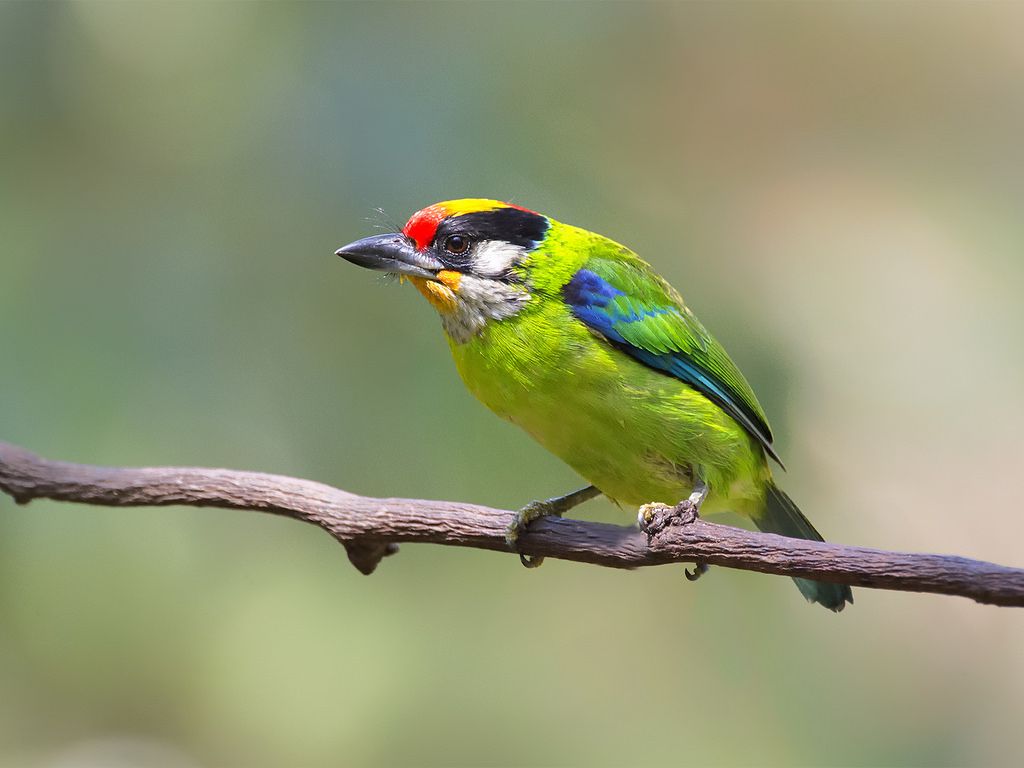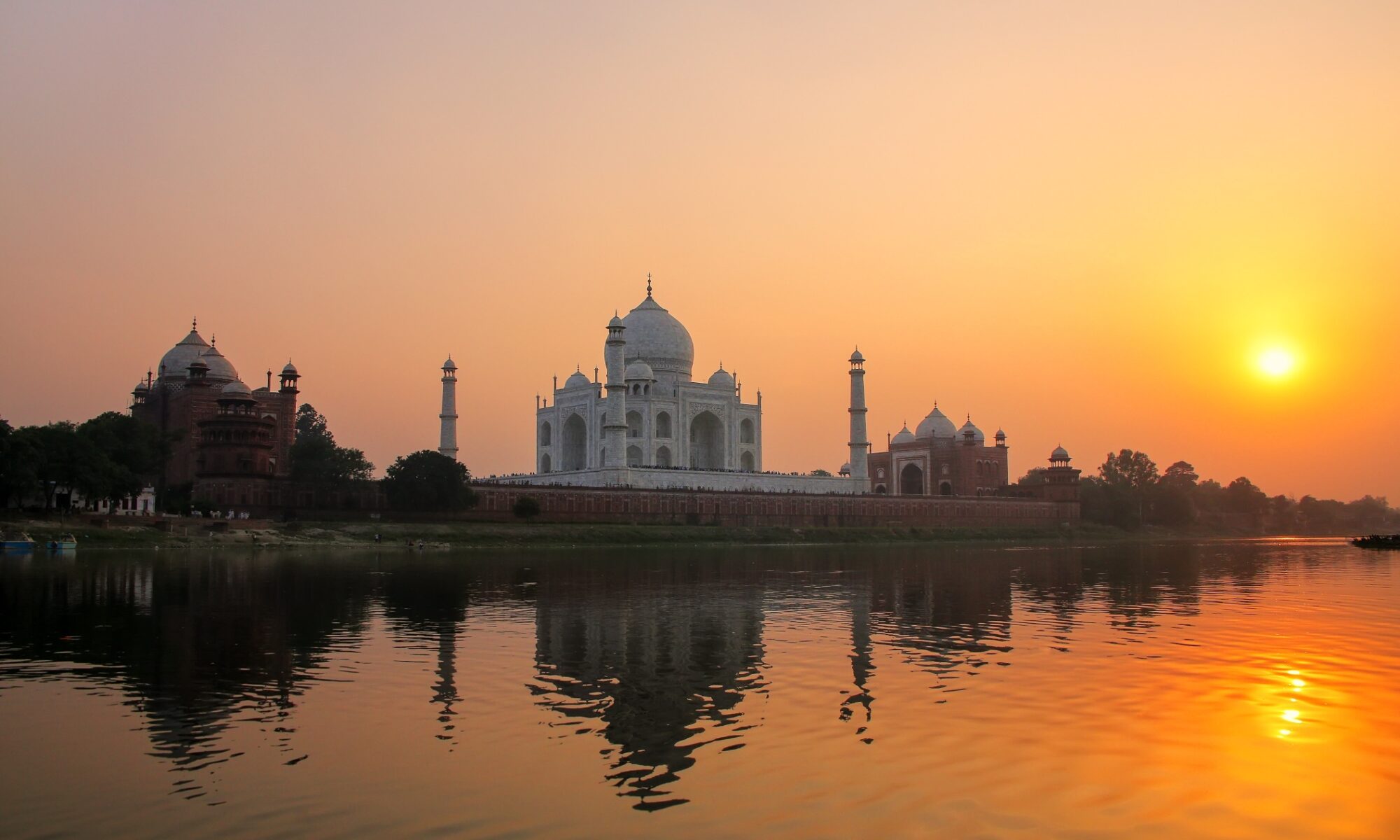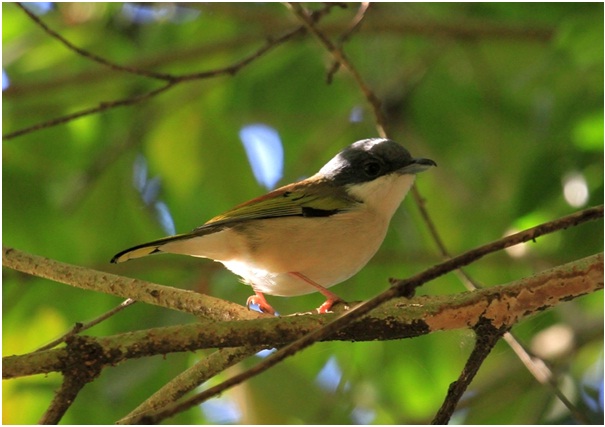Nepal Birding Tour Overview
Duration: 18N/19D
Places Covered: Kathmandu, Pokhara, Annapurna and Chitwan
Nepal Birding Tour Itinerary
Day01: Godawari community forest/Phulchauki Hill
After a early or pack breakfast, you depart for Phulchowki located to 18km southeast of Kathmandu. Phulchauki Hill (2760m) is the highest hill of valley rim in Kathmandu Valley, that offers a perfect introduction to the birds of Nepal. In the area, the regularly recorded resident species area- Black Eagle, Mountain Hawk Eagle , Kaligj Pheasant, Common Hill Partridge , Ashy Woodpigeon, Wedge-tailed Green Pigeon, Mountain Scops Owl, Collared Owlet, Golden-throated Barbet, Speckled Piculet Crimson-breasted Pied and Rufous-bellied Pied Woodpeckers, Grey-chinned Minivet, Striated Bulbul, Orange-bellied Leafbird, Spotted Forktail, Chestnut-headed and grey-bellied Tesias, Chestnut-crowned and black faced Warblers, Rufous-bellied Niltava, Lesser Scaly-breasted Wren-Babbler Streak-breasted Scimitar-Babbler, Grey-throated and Black-chinned Babblers, White-crested, striated, Rufous-chinned and grey-sided Laughing thrushes, Red-billed Leiothrix, Himalayan Cuttia, White-browed Green and Black-eared Shrike-Babblers, Hoary-throated Barwing, Blue-winged Minla, Nepal Fulvetta, Yellow-browed Tit, Brown-throated Treecreeper, Black-throated Sunbird, Maroon Oriole, Eurasian and Lancelated Jays, Red-billed Blue Magpie and Brown Bullfinch. And about 50 species of birds have been known to visit the area as migratory or passage migrants.
Phulchauki’s forest is also rich in flora and butterflies. And some of the main mammals inhabiting the forest include Common Leopard, Muntjac, Monkeys both Rhesus and Common langur with Yellow throated Marten and Orange-bellied Squirrel.
After enjoying the great day at Godawari and Phulchauki you will return drive and transfer to your hotel in Kathmandu
Day 02: To Pokhara 930m, 7 hours
The drive to Pokhara is very scenic, that also provide you to explore some more parts of the country with a stop over to check out the Trishuli riverside for this iconic species Ibissbill that spends its winter down in lowland and travels back to mountains for breeding. Lunch will be provided on the way. Once arrived in Pokhara, you will be transferred to your hotel. Time permitting, you will explore the lakeside for birds and enjoy the excellent views of the Annapurna Range and Phewa lake.
Day03: Day at Pokhara
Today you will explore the hill side forest in the north of Pokhara above the Phewa lake. And along with numerous species of birds, the excellent view of amazing Annapurnas and Machhapuchra peaks will be very rewarding, that Pokhara is famous. Species of birds today can be seen includes – Red-thighed Falconet, Pallid and Pied Harriers, Eurasian Griffon, Red-headed and Eurasian Black Vultures, Kalij Pheasant, Puff-throated Babbler, White-crested and Rufos-chinned Laughing Thrushes, Red-billed Laiothrix, Minivetts, Crimson Sunbird, Maroon Onole, Lesser Racket-tailed Drongo, Red-billed and Green magpies, Long-tailed Mountain Thrush, Chestnut-headed and Grey-bellied niltavas and snowy-brown Flycatcher, Long-tailed Broadbill, White-tailed Robin, Spiny Babbler, white-browed Scimitar-Babbler, Bulbul, Black-backed Forktail, Pale blue Flycatcher with Ducks, Gulls, Waders, Terns by the lakeside
Return to Hotel after a great birding adventure today!
Day04: Thulokot 2100m, 6-8 hours
After a short drive to Phedi (40minute), you start your birding adventure. The trail through the forest makes steep climb to arrive on the terraced field and settlement with the view around. The sight and sound of Great Barbet, Treepie and Magpie with the soaring of vultures on the side is lovely. The trail makes another short climb to emerge on the ridge, that is a lower Dhampus to continue to main village, where you will have lunch. And continuing through the forested ridge with the view with chances of seeing many vultures and other species of birds will be a great sight before we arrive at Thulokot, one of the best place where the raptor counts is going on every year in autumn season.
Day05: To Modi Riverside 1400m, 5-6 hours
Wake up early to enjoy the Himalayan view with beatiful birds sound around. Do birding around in thye morning before breakfast. The trail today is through the forest ridge,creeks and hillside before coming out in open at Tolka to contine to Landruk to desecnd steeply down to Modi Riverside for the overnight lodge. Birds thatb is likely seen along the trail today includes Red-headed and Eurasian Vulture, Black and Bonelli’s Eagles , Mountain Hawk-Eagle, Common Hill Partridge, Striated Bulbul, Speckled and Ashy Woodpigeons , Barred Cuckoo-Dove, Collared Owlel, Upland Pipit, Golden-throated Barbet , Bay and Crimson-breasted Pied Woodpeackers , Slaty-backed and Spoted Forktails , Chesnut-headed Tesia, Chestnut-crowned and Black-faced Warblers , Rufous-bellied Niltava, White-crested and Striated Laughing-thrushes , Red-billed Leiothrix , Himalayan Cutia , Rufous Sibia, Nepal Fulvetta, Yellow-browned Tit , Black-throated Sunbird , Yellow-billed Blue and Green Magpie, Cinnamon Sparrow , Jungle Nightjar , Pacific Swift , Blue-capped Rock-Thrush, Tickell’s Thrush, Little Pied Flycatchers and many more species.
Day06: To Bhainsi Kharka 2300, 5-6 hours
The trail today makes a steep climb to the large village of the area, Ghandruk (2000m) and contineu a gradual climb to end the forest and few beautiful streams to arrive at Bhaisi Kharka (Buffalo pasture) for the overnight.
Area from Ghandruk is really good for numerous species of Laughing Thrushes and Warblers with many other birds.
Day07: To Deorali 3050m, 6-7 hours
Today, the trail takes us through the beautiful forest of oak and Rododendrons, in a easy path to arrive at Tadapani to descend down to Banthati. Tadapani also offers a close up view of Annapurna and other peaks, on a clear day.The trail now following the streams, on a narrow gorge, makes climb to the saddle of Deorali for the overnight. Many birds including Brown Dipper, Water Restarts, Forktails, Thrushes etc can be seen today along the trail.
Day08: To Chitre 2450m, 5-6 hours
The trail today descends through forest, look out for the monkeys and other wild animals such as Rgesus Macaque, Grey Langur, Red Fox, Yellow-throated Marten, Bharal and Orange-bellied Squirrel etc., passing the pastures or clearing and streams.
The birds likely to be seen today includes the raptors such as Black Eagle and Northern Goshwak, pheasant such as Koklas, Kalij and Himalayan Monal( winter), Common Hill Partridge, with Eurasian Woodcock, AshyWoodpigeon, Collared Owlet, Tawny Owl, Honey Guide, Rufous-breasted Bush Robins, Elue-capped Redstart , Plain-backed and Long-tailed Mountain Thrushes, White-collared and Grey-winged Blackbirds, Chestnut and Mistle Thrushes, Chestnut-headed Tesia , Black-faced Warbler, Greater Scaly-breasted Wren-Babbler , Great, Brown and Black-throated Parrotbills,Striated,Spotted and Black-faced Laughing-Thrushes, White-browed ang Green Shrike-Babblers,Hoary Earwing, Black-browed , Yellow-browed and Grey-crested Tits, Bar-tailed Treecreeper , Lancelot Jay, Yellow-billed Blue Magpie, Eurasian Nutcracker, Red-browed Finch,Eurasian Goldfinch,Common Crossbill, Plain Mountain-Finch , Collared Crossbeak, Rosefinches and Bullfinches.
Day09: To Banthanti 2350m, 5-6 hours
After enjoying great birding around, we set on the trail that makes a gradual and steep climb to Ghoreoani with beautiful forests of Oak and Rhododendron.The trail after Ghorepani descends down through another beautiful forest and creeks to Banthati. The trail is rich in numerous species of birds.
Day10: Birthanti 1200m, 5-6 hours
The trail descent steeply, pass Ulleri and cross the river on a suspenses bridge to Tirkhedhunga and ease out to the valley to follow the thr river to arrive at Birethanti on the confluence of Modi. Among many species of bird around Tirkhedhunga, we might get the chance to see and hear Spiny Babbler and Green Magpie, Rufous-bellied Niltava.
Day1: To Pokhara 930m, 6-7 hours
After breakast and little exploration around, we take the trail that climbs steeply to Chandrakot and then to Lumle and Kande with Naudanda, that is also an excellent hillside to watch vultures and many other birds of prey.
In the afternoon, we will drive back to Pokhara for about couple of hours and overnight hotel
Day16: To Chitwan
After breakfast, travel to Chitwan and transfer to the resort near the Chitwan national park. The journey on the road can take some 5-6 hours. Arrival in the resort is followed by checkin and lunch and exploration in the afternoon
Days 17-18: In Chitwan for exploration trip inside and outside the national park.
Full extra coupel of ndays are best to explore the area of national parks inside and outside, that are done on Jeep Safari, boat trip and walks mainly with optional Elephant back safari, that is upto you to use it as most people are opting out for the use of Elephant for this purpose. Chitwans national park with an area of some 1000 sqaure km is the first and finest national nature parks of the country. Chitwan is the heaven for bird life with well over 600 species of birds that includes some of very rare, endangered, globally threatened, wintering, summer visitors, passage migrants and residents birds. Among all these the birds that can be enjoyed there includes – Common and Demoiselle Cranes, Cormorants, Darter,Cinnamon Bittern, Black-crowned Night and Purple Herons, Asian Openbill, Woolly-necked and Lesser Adjutant Storks , Lesser Fishing and Grey Headed Fish Eagle , Brown Fish Owl, Crested Treeswift, Pied and Great Hornbills, Great Slaty (largest woodpecker of the world), Streak-throated,Grey-header, Grey-crowned Pygmy, Rufous, Himalayan Golden-backed and Greater Golden-backed Woodpeckers, Large Woodshrike, Rosy Minivet, Black-crested Bulbul, Golden fronted Leafbird, Pale-chinned Flycatcher, Black-napped Monarch, Asian Paradise Flycatcher, Indian and Blue-naped Pitta, Puff-throated Babbler, White-browned Scimitar-Babbler, Grey- throated Babbler, Crimson Sunbird, Thick-billed Flowerpecker, Hill Mynah, Black-hooded oriole, White-rumped Shama, Lesser Necklaced, Greater Necklaced and Rufous-necked Laughing-Thrushes, Nepal Fulvetta, Streaked Spiderhunter, Yellow-bellied Warbler, Rufous-bellied Eagle, Forest Eagle, Tawny Fish Owls, Red-headed Trogon, White-browned Piculet, Long-tailed Broadbill, Ruby-cheeked Sunbird and Little Spierhunter and many more…
Chitwan national park is also rich in other biodiversity including many major wildlife such as Great one horned Rhinoceros, four species of Deer, Wild Boar, Sloth Bear, Common Leopard, Gaur (Bison) including the big cat- the Royal Bengal Tiger. Gharial and Marsh Magar Crocodile, Python, Monitor Lizard with many other kinds of reptiles and amphibians are found.
Day19: Travel back to Kathmandu
End of tour.
Optional Add on
Phulchauki Birds
From: Kathmandu
Day trip- 7-8 hours
Recommended start time from Kathmandu for lower Phulchauki : 6-7AM
Upper Phulchauki: 5-6 AM
After a early or pack breakfast, you depart for Phulchowki located to 18km southeast of Kathmandu. Phulchauki Hill (2760m) is the highest hill of valley rim in Kathmandu Valley, that offers a perfect introduction to the birds of Nepal.

In the area, the regularly recorded resident species area- Black Eagle, Mountain Hawk Eagle , Kaligj Pheasant, Common Hill Partridge , Ashy Woodpigeon, Wedge-tailed Green Pigeon, Mountain Scops Owl, Collared Owlet, Golden-throated Barbet, Speckled Piculet Crimson-breasted Pied and Rufous-bellied Pied Woodpeckers, Grey-chinned Minivet, Striated Bulbul, Orange-bellied Leafbird, Spotted Forktail, Chestnut-headed and grey-bellied Tesias, Chestnut-crowned and black faced Warblers, Rufous-bellied Niltava, Lesser Scaly-breasted Wren-Babbler, Streak-breasted Scimitar-Babbler, Grey-throated and Black-chinned Babblers, White-crested, striated, Rufus-chinned and grey-sided Laughing thrushes, Red-billed Leiothrix, Himalayan Cuttia, White-browed Green and Black-eared Shrike-Babblers, Hoary-throated Barwing, Blue-winged Minla, Nepal Fulvetta, Yellow-browed Tit, Brown-throated Treecreeper, Black-throated Sunbird, Maroon Oriole, Eurasian and Lancelated Jays, Red-billed Blue Magpie and Brown Bullfinch. And about 50 species of birds have been known to visit the area as migratory or passage migrants.
Phulchauki’s forest is also rich in flora and butterflies. And some of the main mammals inhabiting the forest include Common Leopard, Muntjac, Monkeys both Rhesus and Common langur with Yellow throated Marten and Orange-bellied Squirrel.
After enjoying the great day at Godawari and Phulchauki you will return drive and transfer to your hotel in Kathmandu
For Price Contact Us

